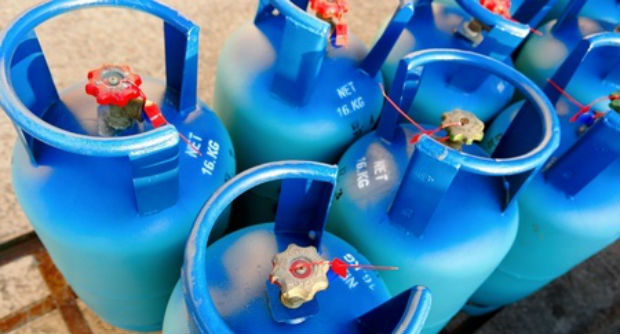
INQUIRER FILE PHOTO
MANILA, Philippines — Just a day after prices of gasoline and other petroleum products were raised on Tuesday, consumers were greeted with a big increase of more than P120 in the cost of an 11-kilogram tank of cooking gas.
Petron Corp. and Phoenix LPG Philippines Inc. jacked up their prices by P11.20 per kg, or P123.20 per 11-kg cylinder of liquefied petroleum gas (LPG), the typical size being used for household cooking.
Solane raised its selling prices by P11.18 per kg, equivalent to about P123 per 11-kg cylinder.
The latest price monitoring of the Department of Energy (DOE) in Metro Manila showed that an 11-kg tank of LPG was selling at P824 to P995 in January, and the latest increase will raise this by 12 percent to 15 percent to more than P1,000 per 11-kg tank in some areas this month.
Both Petron and Phoenix LPG Philippines also increased their AutoLPG prices by P6.25 a liter while that of Cleanfuel was raised by P5.50.
The DOE’s Oil Industry Management Bureau (OIMB) director Rino Abad said that historically speaking, LPG prices reach their highest point twice a year as companies replenish their inventory.
They build their stockpile in November and then in February, and LPG prices decline around April or May, Abad said in a phone interview with the Inquirer.
“Hopefully, since prices peaked in February, it will stabilize in March and won’t [increase by] P10 per kg,” he added.
Big demand
The cost of LPG in the Philippines is adjusted every month, unlike the pump prices of petroleum products which change weekly. In January, the price of LPG decreased by P3.09 to P4.20 per kg and AutoLPG by P2.35 to P2.50 a liter.
The Saudi LPG contract price serves as the basis for pricing cooking gas products in the Philippines and this international price benchmark is set by Saudi Arabia’s state-owned Saudi Aramco at the start of each month.
The LPG contract price for February rose to $790 from $600.50 a month ago, according to the DOE.
“Like all other petroleum products, the Philippines has no influence over the LPG contract price as the country’s domestic requirement is small versus the world demand,” the DOE explained.
The higher international price was due to China’s reopening of its economy, boosting its demand not just for petroleum but also for LPG, according to LPG Marketers Association (LPGMA) president Arnel Ty.
He said the big increase in China’s demand was compounded by the fact that European Union countries were buying their traditionally higher winter season LPG requirements from the Middle East due to the economic embargo on Russian oil and gas.
In a text message to the Inquirer, Rodela Romero, assistant director of the DOE’s OIMB, said demand for cooking gas also surged in Korea and Japan.
“On the supply side, Abu Dhabi and Saudi Arabia are undertaking maintenance activities, while LPG production in Iran declined,” Romero said.
Impact on consumers
Eric Teng, president of the Restaurant Owners of the Philippines, said more expensive LPG would eventually result in higher prices of food products.
“Any increase in cost is always bad and unwanted and will eventually be reflected in higher prices to the end-consumers. No one is immune from high costs,” Teng told the Inquirer in a Viber message.
“It depends on the tolerance of business owners. We don’t want to increase prices as an automatic reaction as that can lower sales,” said Teng when asked on when the consumers can expect to feel the impact of higher cooking gas prices on the cost of food.
Aside from high fuel prices, consumers continue to reel from rising prices of food and other basic necessities.
Inflation is expected to have further accelerated in January as the Bangko Sentral ng Pilipinas (BSP) expects last month’s average to range from 7.5 percent to 8.3 percent, and probably exceed December’s 8.1 percent that was thought to have been the peak.
The BSP said in an earlier statement that increases in electricity rates, prices of petroleum products and key food items, as well as the approval of the increases in water rates and the annual rise in “sin” taxes, were likely the factors behind the higher inflation rate.